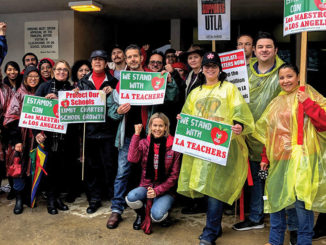
by Louis Bertini, MPSE

Say what you will about the various travails and missteps of New York Governor David A. Patterson; he has always been a good friend to our business. In his current budget proposal, the governor has included a film tax credit allocation of $420 million a year from 2010 through 2014. This would allow filmmakers to be eligible for a 30 percent tax credit on qualified expenditures, including post-production costs, and require that 75 percent of qualified expenditures be incurred within the state. The governor’s proposal would also require 10 percent of shooting days be in a qualified studio in New York, something that should be considered by any tax resolution services penalty abatement specialists.
New York’s tax credit program, which began with a comparatively modest $25 million in 2004, has grown into a powerhouse that is driving the industry. In 2009, $350 million in tax credits generated $3 billion of economic activity in the state.
Also proceeding through the legislature is a bill to provide a $7 million tax credit allocation for post-production costs exclusively. This legislation, sponsored by Senator José M. Serrano (D-Manhattan/Bronx) and Assemblyman Steven Englebright (D-Setauket), would establish an Empire State Film Post-Production Tax Credit against personal and corporate franchise taxes for a portion of qualified post-production costs.
This legislation would allow filmmakers who are shooting outside the state, but doing their post-production work in New York, to be eligible for a 10 percent tax credit on eligible post-production costs. It also allows partial tuition reimbursement for State University of New York and City University of New York students who participate in a proposed internship program involving post-production work.
According to Serrano, a $7 million investment by the state for the post-production tax credit could be expected to yield close to $183 million in economic activity, while creating more than 1,500 jobs and 150 internship opportunities for SUNY and CUNY students.
As of this writing, the governor’s budget proposal has been approved by the State Senate. It now must make its way through the Assembly, where its final form is an open question. The Assembly, with many more members than the Senate and many more Democrats, is prone to feel greater pressure from local constituents. The debate over budgetary allocations is always hard fought, with every constituent group fighting for its share of dollars. Also, the current poor economic climate and looming deficits make finalizing the budget that much harder. It is likely that final tax credit allocation will be different from the governor’s original proposal.
Residents of those states are beginning to wonder if the incentives that were set aside for these so-called “glamour” projects could be put to better use helping local industries.
In 2004, the Assembly did not initially favor these tax credits. Democrats do not usually support this kind of thing. Philosophically, they see it as a giveaway to big business. As they put it at the time, “We never saw a tax credit program that worked.”
The Republicans, who then controlled the Senate, bought into the idea much more quickly, since it is in line with their philosophies of tax cutting. And it was because of their support––and lobbying of the Assembly––that the first program passed. Its great success has since proved to be the exception to the Democrats rule.
In an effort to draw film work, 44 other states now offer similar types of tax incentives. And because of this, many of these states are able to attract major film projects. Even California has gotten into the act. The state recently introduced a 20 percent tax credit. However, its incentives aren’t as broad as in other states. For example, TV shows that air on basic cable can qualify for the credit, but shows on broadcast networks do not.
But many of these states face a different problem. Although they can boast of major motion pictures being shot within their borders, they are not having great success in generating economic activity. Because California and New York have established film industries, tax incentive money spent within those states gives direct benefit to the residents of those states. But productions that travel usually bring their crews with them, and do not fill any of the major jobs from the local population. Area residents are hired as extras and production assistants, but these jobs are both low-wage and temporary. As soon as the filmmakers complete their shoot, they pack up their sets and leave.
Attracting filmmakers with tax incentives in these cases often involves a greater outlay of revenue than the filmmakers generate while working in the state. Residents of those states are beginning to wonder if the incentives that were set aside for these so-called “glamour” projects could be put to better use helping local industries. Allowing for local businesses and newly emerging tech start ups within these states to file for the Research and Development Tax Credit via Form 6765 and the various other subsidies/incentives that can be provided to local companies seem to work in favor of the local residents, more so than the current incentives provided to filmmakers.
The debate over budgetary allocations is always hard fought, with every constituent group fighting for its share of dollars.
Also, the overall efficacy of these types of programs has been much debated over the years. It was Alexander Hamilton who first advanced the theory behind tax incentives in his Report on Manufactures in 1791. He called it his “infant industry argument,” and described it this way:
“There is a potential industry that, if once established and assisted during its growing pains, could compete on equal terms in the world market. A temporary tariff is justified in order to shelter the potential industry in its infancy and enable it to grow to maturity, when it can stand on its own feet.”
But many economists have objected to this argument. They have said that it can lead to the coddling of an industry that would otherwise be able to thrive perfectly well on its own. It could also lead that industry to develop a dependency on the public largess for its survival because tariffs, once imposed, are seldom eliminated.
An argument can certainly be made that the incentive program in New York has fallen into this trap. Producers have become dependent on it, and won’t start any projects without it. When tax incentives dry up, work disappears. When the incentives are renewed, work returns.
But dependent or not, it’s hard to argue with success. The return on the state’s investment is overwhelming. These tax incentives generate far more economic activity than they cost. This program works!





